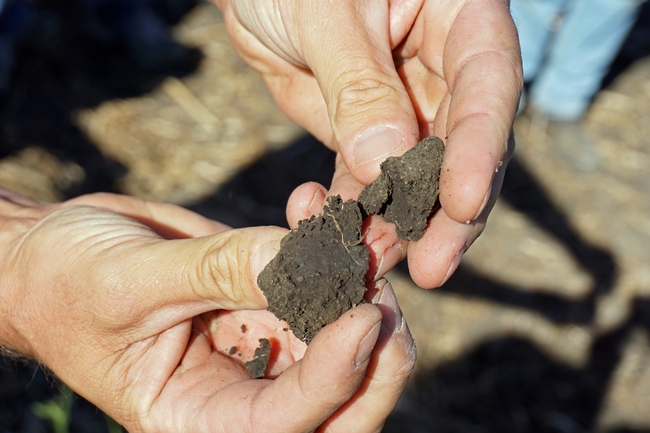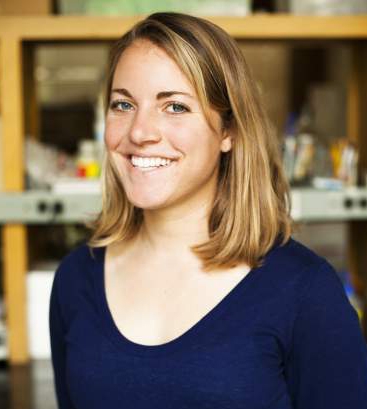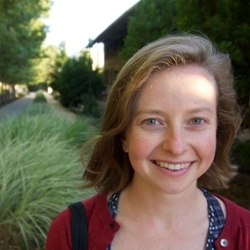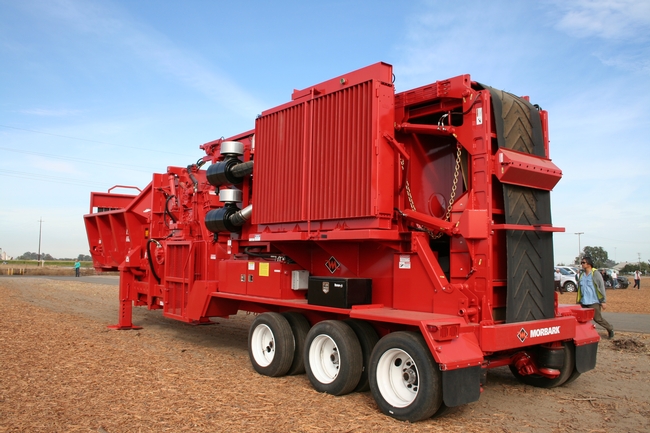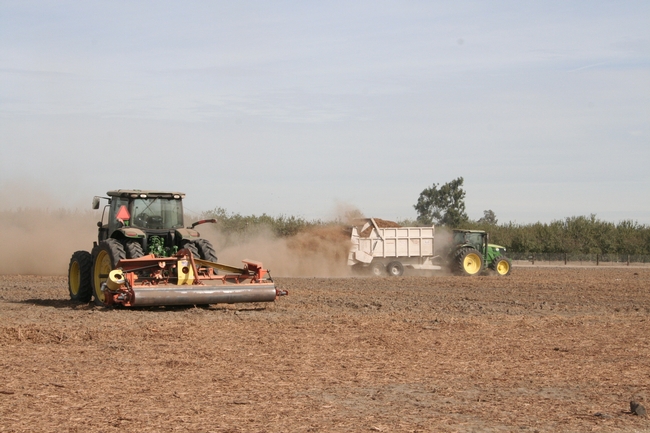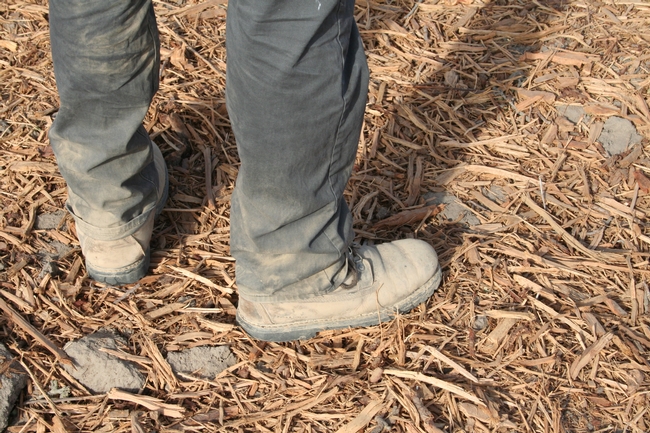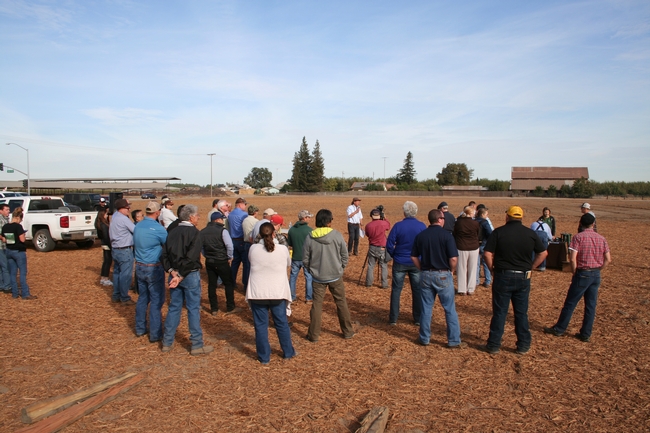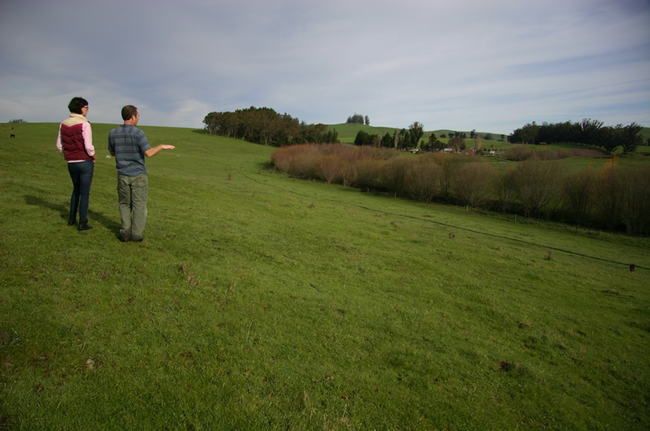Posts Tagged: carbon
UC Cooperative Extension to investigate healthy soil practices with CDFA grants
Six UC Cooperative Extension research projects were awarded funding ranging from $100,000 to $250,000 each from the California Department of Food and Agriculture Healthy Soils Program. The grants are designed to fund implementation and demonstration of on-farm soil health practices that reduce greenhouse gas emissions and store carbon.
One of the grant recipients, John Bailey, director of the UC Hopland Research and Extension Center in Mendocino County, will use the $100,000 award to establish a perennial hedgerow at the center. Hedgerows are not traditionally part of standard ranching practices in Mendocino County, where in the past the center's 5,400 acres of rangeland and surrounding areas were grazed by large flocks of sheep.
“At Hopland, we have pivoted our operation to reflect the current state of the sheep industry in California, with reduced overall sheep numbers and decreased individual flock size, so we will use this project to show our smaller-scale sheep owners how they can enhance the ecosystems of their properties,” Bailey said.
Bailey expects the hedgerow to offer many educational, ecological and practical benefits, including enhancing soil health, increasing soil carbon sequestration, and providing habitat and food sources for beneficial organisms, such as pollinators and birds.
There may also be economic benefits to using sustainable practices in raising sheep. The project will explore the financial costs of implementing hedgerows as well as the opportunity for producers to enter a niche fiber market by offering sustainably produced wool to textile companies and consumers willing to pay a premium to support the ecological benefits of Healthy Soil Projects.
“I'm excited about this opportunity to combine the latest knowledge on environmental sustainability practices with the older traditions of livestock grazing in Northern California,” Bailey said. “This is a progressive step that ties in ecological knowledge that can benefit the livestock ranching model by both enhancing their properties and creating new markets for their products.”
The following projects were also funded by CDFA Healthy Soils Program in 2020:
Integrated sustainable nitrogen management in vegetable cropping systems, $250,000
Maria de la Fuente, UCCE county director and advisor, Monterey and Santa Cruz counties
The implementation of climate-smart agricultural practices within intensively managed vegetable cropping systems is extraordinarily challenging. Often conservation practices cannot be effectively implemented due to operational barriers, resulting in very low rates of adoption.
By demonstrating nutrient management strategies in partnership with a large influential vegetable grower in the Salinas Valley, the project aims to encourage broad scale practice adoption.
Recent research has indicated the addition of organic amendments in combination with nitrogen fertilizers potentially reduces nitrogen-derived greenhouse gas emissions and nitrate leaching while increasing soil carbon stocks. These outcomes will generate significant climate benefits in agroecosystems experiencing heavy tillage and fertilizer inputs.
This project has the potential for statewide impact as the researchers are currently working with the developers of COMET-Farm to provide data and coordinate outreach within vegetable cropping systems. Through direct engagement the team will make integrated sustainable nitrogen management more feasible and agronomically favorable for producers.
Using hands-on COMET-Farm-focused field days and a webcasted sustainable nitrogen short course, the project will provide producers with additional tools to make nutrient management planning decisions that have positive climate and soil health outcomes.
Evaluation of compost application to processing tomato fields in the Sacramento Valley, $100,000
Amber Vinchesi-Vahl, UCCE vegetable crops advisor, Colusa, Sutter and Yuba counties
The project will demonstrate compost applications on two farms in two Sacramento Valley counties, Colusa and Sutter. The researchers will work with Westside Spreading LLC and compare two plant-based compost rates to a control (no compost) over three years. Soil health parameters – such as total carbon and nitrogen, pH, EC, organic matter and fertility analyses relevant to tomato crop production – will be measured.
The benefits of compost applications vary depending on how often they are used, how much is applied, crop rotation, and other management decisions, such as whether compost is incorporated or left on the soil surface. Vinchesi-Vahl expects that over time the compost implementation evaluated in this project will result in lower input costs and improved soil function.
Compost application may reduce the need for fertilizer inputs for some of the rotational crops and provide benefits to the microbial community, thereby improving soil structure and reducing heavy conventional tillage needs.
By improving soil health, the research expects plant health will also be improved, leading to better tolerance to pest pressure from diseases and weed competition.
The two demonstration sites will showcase compost applications and their impact on processing tomato production and annual production soil health. These focused demonstrations will be extremely important in showcasing this soil health practice in the local Sacramento Valley region, providing information to growers from the experiences of collaborators at the two sites.
Evaluation of winter cover crop species for their ability to mitigate soil compaction in an annual rotation, $100,000
Sara Light, UCCE agronomy advisor, Sutter, Yuba and Colusa counties
This project has three components:
- Replicated research plots in which three cover crop varieties are evaluated for improvements in soil structure, specifically subsurface soil compaction
- Fieldscale demonstration plots in which varieties thought to reduce soil compaction are planted and visually assessed for performance in the Sacramento Valley
- Small, single-row hand planted plots in the buffer area, in which a wider number of both summer and winter cover crop varieties will be planted for outreach and demonstration purposes
Combined, these components will enable growers to make more informed decisions about cover crop selection and encourage wider adoption of cover cropping. The outreach objective for this project is to reduce barriers to cover crop adaption among regional growers by increasing knowledge and information about varietal selection and field-scale cover crop management, as well as opportunities to improve soil structure using cover crops.
Healthy soils demonstration project with Cardoza Farm, $100,000
Ruth Dahlquist-Willard, UCCE small farms advisor, Fresno and Tulare counties
This project will demonstrate compost application, hedgerow planting, and application of mulch generated from cover crop residue in a vineyard producing organic raisin grapes. Mulch will be applied directly under the vines, providing ground cover that will conserve soil moisture and decrease weed pressure. Generating the mulch on-farm eliminates the need to transport materials from outside sources.
Currently, production of organic raisin grapes involves frequent tillage under the vines. The cover crop between rows and the mulch under the vines will reduce the need for tillage for weed control and increase soil organic matter. These practices will be showcased at field days that will include bilingual training for small-scale, socially disadvantaged farmers in the San Joaquin Valley.
Application of compost to alfalfa to improve soil structure and fertility, $250,000
Kate Scow and Radomir Schmidt, UC Davis Department Land, Air, Water Resources and UCCE advisors Michelle Leinfelder-Miles and Rachael Long
This project will demonstrate compost application to alfalfa for improving soil structure and fertility. Compost is not typically applied to alfalfa; however, manure application to alfalfa is common in the state's dairy regions.
The over half a million acres of alfalfa in California could represent an important repository for compost, for which a large land base of spreading may be needed as municipalities convert organic waste management streams to diversion from landfills.
Alfalfa has the ability to immobilize large amounts of nitrogen and phosphorus, nutrients of concern in the concentration of organic wastes due to their potential to contribute to water pollution. Furthermore, alfalfa growers are interested in the potential of compost to improve soil structure in their alfalfa fields, as many growers report suffering from the large cracks that form in soils during the wet-dry cycles of alfalfa surface irrigation management.
Compost application has been anecdotally reported to alleviate soil cracking in another perennial crop, almond orchards in the Central Valley, but soil structure improvement via management practices like compost application has received little research attention thus far. Westside Spreading LLC is collaborating on this project.
Carbon Neutrality Initiative fellows seek to reduce our carbon footprint
UC Berkeley doctoral candidates Jose Daniel Lara, Allegra Mayer and Carmen Tubbesing, UC ANR's Carbon Neutrality Initiative (CNI) fellows for 2017-18, are studying new sources of renewable energy and strategies to cut carbon emissions.
The UC President's Carbon Neutrality Initiative Student Fellowship Program, established in 2015, funds student-generated projects that support the UC system's goal to produce zero-net greenhouse gas emissions by 2025.
Each fellow will receive $3,000 to fund their sustainability-themed project.
The 2017-18 CNI fellows:
Jose Daniel Lara of San Jose, Costa Rica, is a first-year Ph.D. candidate in the Energy and Resources Group at UC Berkeley. Lara aims to determine the feasibility of producing electric power from dead trees. To analyze the resources available from tree die-off, he will develop a method to simulate harvesting of dead trees and evaluate the cost of harvesting dead biomass for electricity production. These results will inform policies regarding the use of biomass feedstocks to generate electric power and help mitigate the consequences of massive tree die-offs in forest communities throughout California.
Allegra Mayer of Palo Alto is a fourth-year Ph.D. candidate in the Department of Environmental Science, Policy, and Management at UC Berkeley. Mayer is studying the potential for storing carbon in grassland soils across California to reduce global temperatures. Allegra will combine laboratory incubations with a state-of-the-art carbon model (DayCent) to measure and predict the effect of compost applications on grassland soil. She will then apply these results to quantify the potential change in grassland productivity and soil carbon storage associated with compost amendments. This will allow her to model the impact of climate change on the carbon cycle at these sites.
Carmen Tubbesing of Redmond, Wash., is a fourth-year Ph.D. candidate in the Department of Environmental Science, Policy, and Management at UC Berkeley and a fellow in the Graduate Student Program in Extension. The recent California drought led to a massive tree die-off, particularly in the southern Sierra Nevada, that will have long-term impacts on forest carbon storage. To gain a better understanding of the impact of carbon from dead trees, Tubbesing will calculate forest carbon transfers from live tree pools to dead pools between 2012 and 2016.
Planet-friendly orchard recycling makes money sense
The numbers are beginning to trickle in confirming UC Cooperative Extension advisor Brent Holtz' hunch. Chipping and returning expired almond orchards into the soil where they grew is not only environmentally sound, it is economically smart.
(View a three-minute video of the machinery in action at the end of this post.)
After about 20 years, almond orchards' productivity and vigor begin to decline. Most farmers remove the old trees and plant younger, more vigorous replacements to keep up almond production.
In the past, old trees were easily and cheaply disposed of: they were pushed into a pile and set on fire. Air quality regulations have all but eliminated the practice.
At first, grinding the trees and sending the chips to a co-generation plant was a farmer's preferred option. The companies that used biomass for electricity generation paid an acceptable sum – about $600 per acre – for the wood chips, which helped offset the cost of chipping and hauling the trees off the property.
However today, electrical utilities are looking for clean, renewable energy sources like wind and solar.
“Cogeneration plants burn wood biomass, which still releases carbon dioxide and methane into the atmosphere,” Holtz said. “Many are losing contracts and shutting down.”
Holtz sought another cost-effective alternative, and believes incorporating the wood into the orchard floor may be the answer. Although initially expensive, adding $400 per acre to the $600-per-acre cost of chipping the old trees, the organic matter and nutrients released by the woodchips over time appear to boost yield to a level that covers a chunk of the cost.
In preliminary research, Holtz found that almond orchards where old wood was incorporated into the soil were averaging about 1,800 pounds of meat nuts per acre, while the orchard where old trees had been burned averaged 1,600 meat nuts per acre.
“Almonds sell for about $2 to $3 per pound. To have a 200-pound average yield increase per acre, you've made up the cost of incorporating the wood in just one year,” Holtz said. “It would be even more affordable if farmers can sell carbon credits for the biomass that they sequester in the ground.”
Holtz recently demonstrated two approaches for incorporating almond trees into the soil. The first, which was also used in the study eight years ago at the UC Kearney Agricultural Research and Extension Center in Parlier, is a 50-ton rock crusher called the Iron Wolf. It lumbers down the tree row, grinding up whole trees in place, then reverses over the mangled wood to incorporate it into the ground.
“We thought this one-machine process was the answer,” Holtz said.
G & F Ag Services in Ripon, which has made a business of chipping and hauling almond wood to a co-generation plant, conceived another plan. It modified a manure spreader to spray ground-up wood chips across the orchard floor. Holtz worked with Manteca farmer Louie Tallerico to give the new process a spin.
“This required five different machines working together compared to one Iron Wolf. In this process, the trees have to be excavated by an excavator, then hauled to the wood chipper with a front-end loader. The trees have to be fed into the wood chipper, then the wood chips have to be spread on the orchard floor,” Holtz said. “Another machine, a disk or roto tiller, incorporates the chips into the soil.
The five machines combined are a tremendous time saver.
“The Iron Wolf could do about two acres per day,” Holtz said. “This process can do 15 or 20 acres per day.”
Tallerico opened his farm for a field day in October to demonstrate parts of the process to other farmers and industry representatives. Participants stood on layer of fresh-cut wood chip mulch where a full-grown almond orchard stood just weeks before. The spreader demonstrated the ease with which the wood chips are dispersed evenly across the orchard floor, and a tiller mixed the wood chips into the soil.
The Tellarico orchard will now be the site of research – funded by the California Almond Board – to be conducted by Holtz and a team of scientists interested in documenting the growth and development of the new almond orchard among the remnants of its predecessor.
“In the previous study, three years after incorporating the old trees into the soil we started to see the nutrient benefit,” Holtz said. “This was done at Kearney, where we incorporated a peach orchard that had about 30 tons of organic matter per acre. Almond trees are larger, so here we have 86 tons of organic matter being returned to the soil.”
In the new study, the scientists will determine whether the nutrient benefits found in early research still hold true, whether the wood chips in the soil stunt the new orchard or boost its growth, whether the new orchard suffers from replant disease, and the fate of good and bad nematodes (tiny soil-borne worms) in the new orchard.
“We will also study the carbon budget and continue the life cycle assessment of almond with this practice, to better understand the benefit of these processes,” Holtz said.
Counties can offset greenhouse gas emissions with stream restoration
“We have long known that stream revegetation improves wildlife habitat and enhances water quality, but that fact that the vegetation and trapped sediment capture carbon underscores the importance of this conservation practice,” said David Lewis, a UC Agriculture and Natural Resources (UC ANR) watershed management advisor for Marin, Sonoma and Napa counties.
Going back to the time when Gen. Mariano Guadalupe Vallejo was running long-horn cattle on a vast tract of land in Alta California, ranchers didn't always understand the value of the trees, shrubs and grasses that grew around rangeland waterways.
Vallejo removed vegetation because it provided a hideout for grizzly bears that attacked his cattle and pilfered hides being tanned. In later years, authorities coached landowners to alter streams and remove plants to increase stream flow and improve flood control.
Beginning in the 1960s, the environmental impacts of removing trees and plants became apparent and public funds were made available to share in the cost of restoring streamside vegetation on private land, said Lewis, who is also director of UC ANR Cooperative Extension in Marin and Napa counties. Over a period of three years, he and a team of UC and local scientists studied the stream revegetation projects that took place from about 1970 to just recently. They documented the carbon sequestration benefits of stream revegetation and calculated the value based on the current market for carbon credits. The results were shared in a report released this month, Mitigating Greenhouse Gas Emissions through Riparian Revegetation.
“In Marin County, for example, the cost per metric ton for carbon dioxide equivalence sequestered with revegetation was $19.75. The carbon market is currently paying about $12.50,” Lewis said. “There is about $7 that we haven't made up. But when you think about the other benefits of riparian restoration – reduced sediment, restored habitat for migratory songbirds and other wildlife – I would bet that value to be much greater than $7.”
Lewis' research will be of interest to county governments as they strive to reduce total greenhouse gas emissions to comply with the requirements of the 2006 California Global Warming Solutions Act (AB 32). The legislation requires California to reduce its greenhouse emissions to 1990 levels by 2020. As part of the law, local governments must write a “Climate Action Plan” to report how they will monitor and track progress in reducing and offsetting greenhouse gas emissions.
“It may make sense for governments and project proponents to invest in creek restoration and other farm conservation practices to reach and surpass their carbon emission reduction goals,” Lewis said.
Through 1990, Marin ranchers restored more than 25 miles of stream with willows, oaks and other trees and shrubs. Those plants trapped sediment contain an estimated 80,265 metric tons of sequestered carbon – an amount equal to emissions from 61,959 passenger cars in one year.
Lewis estimates there are several hundred miles of unrestored streams in Northern California coastal counties. And the implications of this study have application for rangeland streams throughout California.
“This represents tremendous potential for carbon sequestration,” Lewis said. “And rancher interest in stream restoration has never been higher. Working with the ranchers to plant trees and shrubs along our waterways presents a significant opportunity to offset carbon emissions.”
An initiative to maintain and enhance sustainable natural ecosystems is part of UC Agriculture and Natural Resources Strategic Vision 2025.
California's honeypot, from cradle to grave
September is national honey month, a time when pollination season has largely ended and many commercial beehives are harvested for their honey. Now for the first time, beekeepers have a new tool to track just how much energy their efforts take, and the amount of greenhouse gases those efforts emit. With growing consumer interest in the carbon foot prints of products and cap-and-trade legislation under AB32, emissions-tracking is becoming increasingly important for agricultural producers - including beekeepers and honey makers.
Beekeepers are trucking some 1.5 million bee colonies around the state to help pollinate California’s 760,000 acres of almond orchards and 50 other fruit and nut crops. They continue to pollinate vegetable crops throughout the summer and early fall. Beyond pollination, bees are big business here. California is the second largest producer of honey in the country, producing over 27 million pounds of honey in 2010.
The chain of production leading to pollination and honey processing is long. Apiaries require hive construction and management, bee travel for nectar and pollination, honey extraction, processing and packaging. And each stage requires energy inputs in the form of fuel, electricity or nutrients.
Researchers at UC Davis and the UC Sustainable Agriculture Research and Education Program (SAREP) have created a way to calculate how much energy is required to produce a honey product, and the amount of greenhouse gas emissions that are created throughout the process. Looking at the chain of production for an entire operation, researchers can estimate the carbon footprint for a single kilogram of honey.
Recently, SAREP released a honey carbon calculator to help individual beekeepers, both hobbyist and commercial, track the greenhouse gases of their own apiaries.
The calculator is based on a life cycle assessment (LCA) of honey production, a cradle-to-grave accounting system used to track the energy requirements of products as diverse as cement, hybrid cars and almonds.
“With agriculture, a life cycle has to include all of the upstream materials acquisition and energy acquisition before you even get to the agricultural field. So we’re looking at the impacts of all of that,” said Sonja Brodt, program coordinator at UC SAREP who works on life cycle assessments.
The LCA of honey production is the first of its kind in the U.S. Alissa Kendall, assistant professor in Civil and Environmental Engineering, spearheaded the effort to assess honey’s greenhouse gas impact. To her surprise, “the big finding was the role of transportation in the life cycle.” Transportation of bee colonies for pollination and over-wintering uses the greatest energy and creates the greatest emissions.
Tracking these emissions is ultimately a benefit to a farmer’s bottom line, said Kendall.
“There’s occasionally hostility to climate change and greenhouse gas research because it’s a very politicized issue," she said. But researchers find that “efficiency in operations is often well aligned with reducing greenhouse gases and climate footprint . . . and often goes hand in hand with reducing energy use and dependence on fossil fuels and oil.”
Elias Marvinney, a graduate student researcher focusing on agriculturally-produced greenhouse gas emissions said there are concrete financial rewards for being a net-carbon sequesterer.
"If you can put a carbon negative sticker on your product, then you just expanded your market," Marvinney said.
Currently, honey producers and processors can input their records into the carbon calculator to determine which part of their operations have the greatest emissions and see where the greatest improvements can be made. The calculator can be found at: http://asi.ucdavis.edu/sarep/sfr/life cycleassessments/honey
The calculator comes with a guide. Sonja Brodt of UC SAREP can address questions.
The article, Carbon footprint and air emissions inventories for US honey production: case studies, written by Alissa Kendall, Juhong Yuan and Sonja Brodt, was published in September's issue of The International Journal of Lifecycle Assessments.


